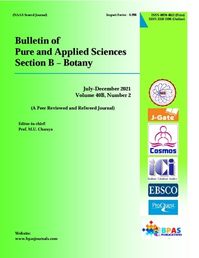Modelling of Potential Distribution of Helichrysum nuratavicum Krasch (Asteraceae) in Uzbekistan
DOI:
https://doi.org/10.48165/Keywords:
Helichrysum Nuratavicum Krasch, areal, Temperature, precipitation, Climate, Potential, TASH, MaxEntAbstract
The strong impact of climate change on the distribution of plant species on Earth is currently of great interest in the field of biogeography. In this research work, the endemic Helichrysum nuratavicum plant from the flora of Uzbekistan was selected to be studied. For current and future climatic scenarios for H. nuratavicum, the real and potential areal was assessed based on high-precision environmental data, geographical distribution, ecology, data of the National Herbarium of Uzbekistan (TASH) and the results of scientific field research, annual precipitation and average temperature ratios using Diva-GIS, Maxent program. In this case, the distribution was assessed on the basis of environmental factors, and the areas with the most optimal conditions were predicted according to climate change scenarios, the distribution of the species rcp 8.5. Based on the climatic scenario, and also the maps representing the distribution of the species were created. The results of our research have shown that areas with an optimal climatic index of the geographical area of the species will expand to the south in all future scenarios.
Downloads
References
. Akbarov F.I., Kodirov U.X., and Tojibaev K.Sh. (2020). Modeling and analysis of the geographical distributionof some species of the family. News of KarSU. 3, 22-31.
. Fick S. E., and Hijmans R. J. (2017). WorldClim 2: new 1km spatial resolution climate surfaces for global land areas. International journal of climatology. – Т. 37(12), 4302-4315.
. Fois M. et al. (2018). Using species distribution models at local scale to guide the search of poorly known species: Review, methodological issues and future directions. Ecological Modelling. – Т. 385, 124-132.
. Flora of the USSSR. (1959).–М.–Т. 25, 404–431.
. Flora of the Uzbekistan. (1962). Tashkent. –Т. VI. 78–81.
. Keys to plants of central Asia Tashkent (1993).–Т. X. – pp. 464–467. [7]. Khujanov A.N. (2020) Biology and reseurces of Helichrysum maracandicum Popov ex Kirp. In Uzbekistan Diss. (PhD) biol. nauk. –Tashkent. pp. 17-18. [8]. Mustafaev I.M., and Khujanov A.N. (2020) First record and new host of Uromyces helichrysi (Pucciniales) from Uzbekistan Novosti sistemtiki nizshikh rastenii. pp. 381-385. https://doi.org/10.31111/nsnr/2020. 54.2.381
. Phillips S. J., Anderson R. P., and Schapire R. E. (2006) Maximum entropy modeling of species geographic distributions. Ecological modelling. Т. 190(3-4), 231-259.
. Phillips S.J., Dudík M. (2008) Modeling of species distributions with Maxent: new extensions and a comprehensive evaluation. Ecography. 31(2), 161-175.
. Red book of the Republic of Uzbekistan (2017). Тashkent. p. 325. [12]. Sandanov D.V., & Pisarenko O.Y. (2018) Bioclimatic modeling of Crossidiumsquamiferum (Viv.) Jur. (Pottiaceae, Bryophyta) distribution. Arctoa. 27(1), 29-33.
. Stocker, T.F., Qin, D., Plattner, G.-K., Tignor, M., Allen, S.K., Boschung, J., Nauels, A., Xia, Y. Bex, V. and Midgley, P.M. (2013). Climate change 2013: The physical science basis. Contribution of working group I to the fifth assessment report of the intergovernmental panel on climate change. Т. 1535.
